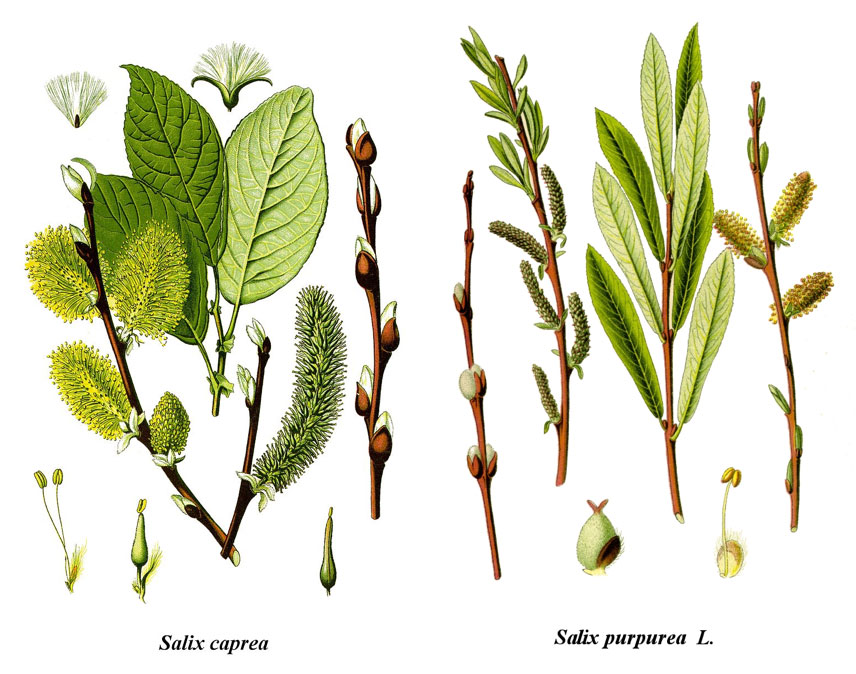The Weeping Willow, also known as Salix Babylonica or Babylon Willow is a popular ornamental tree known for its graceful, drooping branches and leaves. Weeping Willows are among the most iconic and recognizable trees, and hold deep cultural and symbolic meaning in many civilizations throughout history. With their mournful, cascading habit, Weeping Willows evoke a sense of melancholy and tranquility, which has inspired many works of poetry, art, and literature.
Table of Contents
Weeping Willow Is And Its Significance
Weeping Willows are native to China but have been cultivated and naturalized in temperate regions around the world. They thrive near water and are commonly found along riverbanks and ponds. Salix Babylonica are fast-growing trees that can grow up to 50 feet tall and wide, with long, slender, yellow-green leaves. Their branches hang down elegantly from a twisted trunk, swaying gently in the breeze. During spring, Babylon Willows produce attractive catkins which contain their small seeds.
Also Know About: Discover The 3 Main Types of Forest Trees You Must Know

Popularity and Symbolism
The characteristic drooping shape of the Weeping Willow‘s branches and leaves gives it a sorrowful, weeping appearance. This distinctive form has made the tree a symbol of sadness and mourning in many cultures. Images of Babylon Willow draping over tombstones are a familiar funerary motif. Despite its association with grief, the grace and tranquility of the Salix Babylonica have also inspired more positive symbolism related to flexibility, healing, and femininity. Their affinity for water has linked Weeping Willows to qualities like fluidity, intuition, and connection to nature.
History and Origins of Weeping Willow
This tree has a long and rich history spanning cultures and continents. Though native to China, Weeping Willows quickly spread through ornamental cultivation to become a beloved tree worldwide. They have taken root in mythology, art, literature, and funerary symbolism across many civilizations.
The first Weeping Willows originated in China, where they grew wild along the Yangtze River Valley. Weeping Tree were later cultivated as ornamentals, portrayed in ancient Chinese paintings and poetry as symbols of classic beauty. Introduced to Europe in the 18th century, this tree became popular across the continent after their melancholic form captured the Romantic imagination. Salix Babylonica motifs flowed into funerary art, literature, and Victorian hair jewelry.
Cultural And Mythological References To Weeping Willows
In ancient Egypt and Greece, garlands of Salix Babylonica branches were used to symbolize grief at funerals. The Bible also references willow branches in the context of mourning and exile. Willows appear in Greek myth as well, such as when Orpheus’ willow harp floated down a river after his tragic death. Buddhists link the Weeping Willow’s flexible nature to unwavering resilience. In pagan traditions, willows represent female divinities associated with the moon and intuition.
Across cultures, the graceful Babylon Willow retains contradictory associations with grief and solace, permanence and flexibility. Their intertwined history speaks to the depth of meaning a single tree can hold in human experience. Even as the Salix Babylonica spreads into new lands, its origins endure in the sweet sorrow of its flowing, hanging leaves.
Also Know About: Nepenthes Alata, Nature’s Old Secrets of The Carnivorous Adaptation
Physical Characteristics
The Weeping Willow is renowned for its graceful, cascading form and slender leaves. Its fluid, drooping branches create a curtain of foliage that sways gently in the breeze. Beyond its melancholy aesthetic, the Salix Babylonica has adapted unique physical traits to thrive in its native wetland habitats.

Drooping Branches
The most iconic feature of the Salix Babylonica is its long, pliant branches that bend downward from the trunk. The supple branches can sweep all the way to the ground, creating a dome-like silhouette. The drooping tendency is caused by the weight of the branches themselves rather than weepiness. The flexibility allows branches to sway without breaking off in wind or storms. Draping foliage also provides dappled shade that Babylon Willow appreciate at their watery margins.
Slender Leaves
Weeping Willows have elongated, tapered leaves measuring 3-6 inches long. The slim, yellow-green leaves flutter in the slightest breeze. Their narrow shape reduces wind resistance and transpiration. The leaves lend a soft, feathery texture to the Weeping Willow’s cascades. Leaves emerge light green in spring and fade to yellow before falling in autumn.
Adaptability
Despite their graceful appearance, Weeping Willows are remarkably resilient trees. Their expansive root systems efficiently absorb moisture from soil or streams. Their lithe branches withstand flooding. Babylon Willow can thrive in either wet or briefly dry conditions. They flourish across temperate regions but can survive in subarctic cold and subtropical humidity. The Weeping Willow’s beauty is matched by its environmental adaptability.
Symbolism and Meaning
With its mournful form and affinity for water, the Weeping Willow has accumulated rich symbolic meaning across cultures. The drooping tree evokes qualities like grief, femininity, flexibility, and connection to nature and spirit.

Grief and Mourning
The cascading branches of the Salix Babylonica naturally evoke weeping, so the tree has become a poignant symbol of mourning. Willows appear on grave sites and funerary art to represent grief, loss, and pensive melancholy. Yet willows also represent consolation and quiet acceptance flowing through sorrow. Their sad beauty offers cathartic release.
Femininity
Pagan traditions have long associated willow trees with feminine divinities and lunar cycles. Willows represent the sacred feminine, intuition, fluidity, and flexibility, as opposed to rigidity. Willows are incorporated in rituals and magic related to women’s spirituality and mystic perception.
Flexibility and Healing
Weeping Willows withstand stormy adversity by bending, not breaking. Buddhists appreciate willow trees as symbols of flexibility, resilience, and finding inner peace amidst life’s turbulence. Willow branches appearing in Homer’s Odyssey grant protection from misfortune. Willow bark contains salicin, inspiring medicinal associations of healing and pain relief.
Nature and Spirit
Weeping Willows grow along waterways, representing our connection to nature’s ebb and flow. Their shade offers sanctuary, while willow branches symbolize magic and prophecy in Celtic lore. The Salix Babylonica embodies yin energies – feminine, dark, receptive, and watery reflection. They represent the divine in nature, and peaceful contemplation.
Cultural Significance
The graceful Salix Babylonica has been cultivated ornamentally for centuries, inspiring everything from landscape design to poetry. Their likeness flows through funerary art, literature, religion, and folklore. Weeping Willows transcend cultures as symbols of sadness, femininity, and connection to the spiritual in nature.

Art and Literature
Weeping Willows first emerged in Chinese art and poetry, representing wispy beauty. Willow motifs flourished across 18th-century Europe, adorning portraits, jewelry, and porcelain alongside urns and tombs. Romantic poets saw elegant melancholy in their drooping boughs. Willow trees line the river in Kenneth Grahame’s Wind in the Willows, a pastoral literary escape.
Landscaping
Weeping Willows are iconic and beloved ornamental trees. They lend focal drama, sound, and movement to gardens, parks, and campuses. Graceful willow branches provide living, diaphanous curtains. Solitary willows stand pensive guard over ponds and streams. Care must be taken to allow their extensive roots room to spread.
Myth and Ritual
In Greek myths, willows represent mourning, femininity, and music – seen in the tales of Orpheus and Persephone. Celtic wisdom links willow groves with prophecy and enchantment. Wiccans gather willow branches for moon rituals. Willow palms distributed at Easter symbolize Christ’s passion. The diverse lore repeats universal themes of sorrow, solace, and feminine spirituality.
Also Know About: Dragon’s Blood Tree The Nature’s Wonder
Ecological Importance
Beyond their ornamental and literary significance, Salix Babylonicas provide critical environmental benefits. Their dense roots prevent soil erosion along waterways. Their fallen leaves feed aquatic food chains. Birds nest in willow branches, while pollinators harvest their early nectar. Weeping Willows support watershed ecosystems.
Soil Stabilization
Weeping Willows thrive along riverbanks, where their wide-spreading roots cling to shorelines. The sturdy root networks reinforce soil structure against the erosive force of flowing water. Willows prevent nutrient loss that damages water quality downstream. Their presence preserves healthy aquatic habitats.
Wildlife Habitat
Cavities in old weeping willows provide nesting sites for birds. Catkins offer an early spring food source to bees, butterflies, and hummingbirds. Fallen leaves degrade into nutrients that feed algae, aquatic invertebrates, and fish fry. Willow branches shelter small mammals who nibble on their bark. Babylon Willow sustain diverse food webs.
Conservation
Some Salix Babylonica varieties have become invasive risks in regions outside their native range. However, there are also efforts to protect native willow species by restoring wetland habitats and controlling herbivory. Careful cultivation of non-invasive Weeping Willow cultivars allows us to enjoy their grace without environmental costs.
Popular Varieties of Weeping Willows
Weeping Willows display diverse shapes, sizes, and growth habits across different cultivars. Some popular varieties include:
:max_bytes(150000):strip_icc()/what-are-weeping-trees-3269676_final_AC-5c51f1ffc9e77c0001859bb3-04201e82003c41cca561826b00e2f8d0-602fc4aa8697460eabca71502a339a20.jpg)
Babylon Salix Babylonica
- Salix babylonica
- The classic Salix Babylonica with long, pendulous branches.
- Broad, umbrella-shaped form spreading up to 50 feet.
- Prefers moist soil. Good near water features.
- Susceptible to breaking in snow or storms.
Golden Salix Babylonica
- Salix x sepulcralis ‘Chrysocoma’
- Slender branches that arch and sweep ground.
- Bright yellow twigs that glow against green foliage.
- Grows 30-40 feet tall and wide.
- Best for small yards. Needs frequent pruning.
Tortuosa Weeping Willow
- Salix x sepulcralis ‘Tortuosa’
- Distinctively twisted, spiraling branch structure.
- Irregular, contorted shape with textured appearance.
- Slow growth to 25 feet tall, 15 feet wide.
- Makes a unique specimen tree.
When selecting a Salix Babylonica, consider the intended purpose, available space, and desired maintenance. The cascading babylonica is iconic while twisted tortuosa offers architectural distinction. Golden willow glows brightly but requires more care. Consult with local nurseries to choose the perfect weeping variety.
Uses of Weeping Willows
Beyond their ornamental beauty, Weeping Willows have served various practical uses throughout history thanks to their flexible wood and medicinal compounds.

Crafts
Salix Babylonica branches can be used to weave baskets, fences, and living willow structures. Their flexibility also makes them ideal for wicker furniture. Artists incorporate willow branches for organic sculpture and living art installations.
Medicine
Weeping Willow bark contains salicin, a natural compound similar to aspirin. Willow bark tea and poultices have been used to relieve headaches, fever, and arthritis. The leaves offer anti-inflammatory benefits as well. However, caution is required due to potential side effects.
Erosion Control
Babylon Willow are planted to stabilize shorelines and streambanks. Their interwoven root networks prevent soil erosion and filter runoff. Bioengineering projects use living willow posts and wattles for natural erosion control.
Biomass
As a fast-growing tree, Weeping Willows can produce a high yield of biomass fuel. Willow wood chips are processed into pellets for heating. Short-rotation coppicing can sustainably produce biomass while keeping stools small. More research is needed to optimize yields.
The supple wood and growth habit of Babylon Willow lend them to diverse uses, from alleviating pain to preventing erosion. Their weeping yet resilient nature provides ecological services as well as artistic inspiration.
Also Know About: The Monkey Puzzle Tree A Living Fossil
Conclusion
The graceful, sorrowful beauty of the Weeping Willow has captivated us for centuries. This iconic tree can be found gracing ponds and poetry across cultures. Its origins trace back to China, but the Salix Babylonica has spread its cascading branches into art, literature, mythology, and backyard landscapes worldwide.
The drooping habit that gives the Salix Babylonica its name also imbues it with deep symbolic meaning. Its pendulous form evokes grief, mourning, and melancholy – images of Weeping Willows draping over tombstones are universal. However, the tree also represents more uplifting qualities like strength through flexibility, healing, and connection to sacred feminine energies and cycles in nature.

Beyond inspiring artists and poets, the Salix Babylonica provides important environmental services. Its interwoven roots stabilize shorelines against erosion. Fallen willow leaves feed aquatic and riparian food chains. Birds nest in its branches while bees harvest early pollen from its catkins. Babylon Willows support diverse ecosystems when planted thoughtfully in appropriate spaces.
Cultivating these trees as ornamentals allows us to appreciate their grace up close. There are many lovely varieties to choose from, ranging in size, shape, and color. Babylon Willows can also be incorporated into uses ranging from living willow structures to herbal remedies. No matter how they are embraced, Babylon Willows retain an air of poignant mystique.
The fluid strength of the Salix Babylonica endures as a stirring artistic motif across cultures and centuries. Its bittersweet beauty resonates in the human experience, reminding us that sorrow and joy flow into one another as inevitably as rivers to the sea. The graceful Weeping Willow stands sentinel, telling timeless stories etched in its cascading branches.




